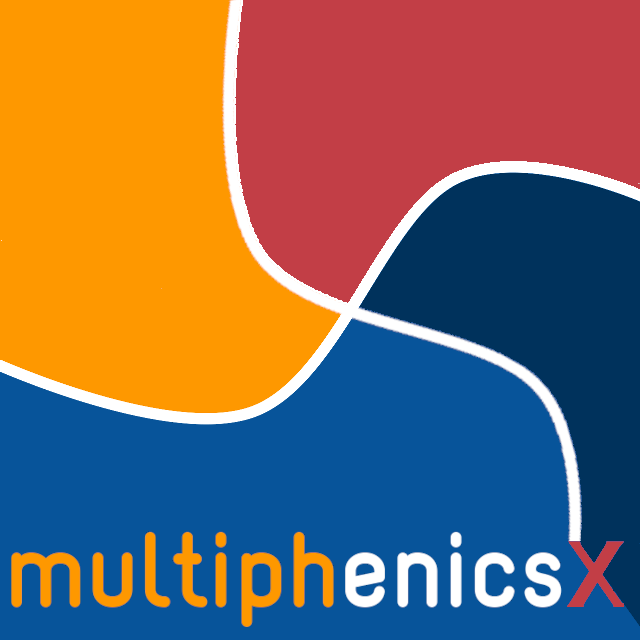

In this tutorial we solve the optimal control problem
$$\min J(y, u) = \frac{1}{2} \int_{\Omega} (y - y_d)^2 dx + \frac{\alpha}{2} \int_{\Gamma_2} u^2 ds$$ s.t. $$\begin{cases} - \epsilon \Delta y + \beta \cdot \nabla y + \sigma y = f & \text{in } \Omega\\ \epsilon \partial_n y = 0 & \text{on } \Gamma_1\\ \epsilon \partial_n y = u & \text{on } \Gamma_2\\ \epsilon \partial_n y = 0 & \text{on } \Gamma_3\\ y = 0 & \text{on } \Gamma_4 \end{cases}$$
where $$\begin{align*} & \Omega & \text{unit square}\\ & \Gamma_1 & \text{bottom boundary of the square}\\ & \Gamma_2 & \text{left boundary of the square}\\ & \Gamma_3 & \text{top boundary of the square}\\ & \Gamma_4 & \text{right boundary of the square}\\ & u \in L^2(\Gamma_2) & \text{control variable}\\ & y \in H^1(\Omega) & \text{state variable}\\ & \alpha > 0 & \text{penalization parameter}\\ & y_d & \text{desired state}\\ & f & \text{forcing term} \end{align*}$$ using an adjoint formulation solved by a one shot approach.
import dolfinx.fem
import dolfinx.fem.petsc
import dolfinx.io
import dolfinx.mesh
import mpi4py.MPI
import numpy as np
import numpy.typing as npt
import petsc4py.PETSc
import ufl
import viskex
import multiphenicsx.fem
import multiphenicsx.fem.petsc
mesh = dolfinx.mesh.create_unit_square(mpi4py.MPI.COMM_WORLD, 32, 32)
# Create connectivities required by the rest of the code
mesh.topology.create_connectivity(mesh.topology.dim - 1, mesh.topology.dim)
def bottom(x: npt.NDArray[np.float64]) -> npt.NDArray[np.bool_]:
"""Condition that defines the bottom boundary."""
return abs(x[1] - 0.) < np.finfo(float).eps # type: ignore[no-any-return]
def left(x: npt.NDArray[np.float64]) -> npt.NDArray[np.bool_]:
"""Condition that defines the left boundary."""
return abs(x[0] - 0.) < np.finfo(float).eps # type: ignore[no-any-return]
def top(x: npt.NDArray[np.float64]) -> npt.NDArray[np.bool_]:
"""Condition that defines the top boundary."""
return abs(x[1] - 1.) < np.finfo(float).eps # type: ignore[no-any-return]
def right(x: npt.NDArray[np.float64]) -> npt.NDArray[np.bool_]:
"""Condition that defines the right boundary."""
return abs(x[0] - 1.) < np.finfo(float).eps # type: ignore[no-any-return]
boundaries_entities = dict()
boundaries_values = dict()
for (boundary, boundary_id) in zip((bottom, left, top, right), (1, 2, 3, 4)):
boundaries_entities[boundary_id] = dolfinx.mesh.locate_entities_boundary(
mesh, mesh.topology.dim - 1, boundary)
boundaries_values[boundary_id] = np.full(
boundaries_entities[boundary_id].shape, boundary_id, dtype=np.int32)
boundaries_entities_unsorted = np.hstack(list(boundaries_entities.values()))
boundaries_values_unsorted = np.hstack(list(boundaries_values.values()))
boundaries_entities_argsort = np.argsort(boundaries_entities_unsorted)
boundaries_entities_sorted = boundaries_entities_unsorted[boundaries_entities_argsort]
boundaries_values_sorted = boundaries_values_unsorted[boundaries_entities_argsort]
boundaries = dolfinx.mesh.meshtags(
mesh, mesh.topology.dim - 1,
boundaries_entities_sorted, boundaries_values_sorted)
boundaries.name = "boundaries"
boundaries_2 = boundaries.indices[boundaries.values == 2]
boundaries_4 = boundaries.indices[boundaries.values == 4]
# Define associated measures
ds = ufl.Measure("ds", subdomain_data=boundaries)
viskex.dolfinx.plot_mesh(mesh)
viskex.dolfinx.plot_mesh_tags(mesh, boundaries, "boundaries")
Y = dolfinx.fem.functionspace(mesh, ("Lagrange", 2))
U = dolfinx.fem.functionspace(mesh, ("Lagrange", 2))
Q = Y.clone()
dofs_Y = np.arange(0, Y.dofmap.index_map.size_local + Y.dofmap.index_map.num_ghosts)
dofs_U = dolfinx.fem.locate_dofs_topological(U, boundaries.dim, boundaries_2)
dofs_Q = dofs_Y
restriction_Y = multiphenicsx.fem.DofMapRestriction(Y.dofmap, dofs_Y)
restriction_U = multiphenicsx.fem.DofMapRestriction(U.dofmap, dofs_U)
restriction_Q = multiphenicsx.fem.DofMapRestriction(Q.dofmap, dofs_Q)
restriction = [restriction_Y, restriction_U, restriction_Q]
(y, u, p) = (ufl.TrialFunction(Y), ufl.TrialFunction(U), ufl.TrialFunction(Q))
(z, v, q) = (ufl.TestFunction(Y), ufl.TestFunction(U), ufl.TestFunction(Q))
alpha = 1.e-5
y_d = 1.
epsilon = 1.e-1
beta = ufl.as_vector((-1., -2.))
sigma = 1.
ff = 1.
zero = petsc4py.PETSc.ScalarType(0) # type: ignore[attr-defined]
state_operator = (epsilon * ufl.inner(ufl.grad(y), ufl.grad(q)) * ufl.dx
+ ufl.inner(ufl.dot(beta, ufl.grad(y)), q) * ufl.dx + sigma * ufl.inner(y, q) * ufl.dx)
adjoint_operator = (epsilon * ufl.inner(ufl.grad(p), ufl.grad(z)) * ufl.dx
- ufl.inner(ufl.dot(beta, ufl.grad(p)), z) * ufl.dx + sigma * ufl.inner(p, z) * ufl.dx)
a = [[ufl.inner(y, z) * ufl.dx, None, adjoint_operator],
[None, alpha * ufl.inner(u, v) * ds(2), - ufl.inner(p, v) * ds(2)],
[state_operator, - ufl.inner(u, q) * ds(2), None]]
f = [ufl.inner(y_d, z) * ufl.dx,
None,
ufl.inner(ff, q) * ufl.dx]
a[2][2] = dolfinx.fem.Constant(mesh, zero) * ufl.inner(p, q) * ufl.dx
f[1] = ufl.inner(dolfinx.fem.Constant(mesh, zero), v) * ufl.dx
bdofs_Y_4 = dolfinx.fem.locate_dofs_topological(Y, mesh.topology.dim - 1, boundaries_4)
bdofs_Q_4 = dolfinx.fem.locate_dofs_topological(Q, mesh.topology.dim - 1, boundaries_4)
bc = [dolfinx.fem.dirichletbc(zero, bdofs_Y_4, Y),
dolfinx.fem.dirichletbc(zero, bdofs_Q_4, Q)]
(y, u, p) = (dolfinx.fem.Function(Y), dolfinx.fem.Function(U), dolfinx.fem.Function(Q))
J = 0.5 * ufl.inner(y - y_d, y - y_d) * ufl.dx + 0.5 * alpha * ufl.inner(u, u) * ds(2)
J_cpp = dolfinx.fem.form(J)
# Extract state forms from the optimality conditions
a_state = ufl.replace(a[2][0], {q: z})
f_state = ufl.replace(f[2], {q: z})
bc_state = [bc[0]]
petsc_options = {
"ksp_type": "preonly",
"pc_type": "lu",
"pc_factor_mat_solver_type": "mumps",
"ksp_error_if_not_converged": True,
}
problem_state = dolfinx.fem.petsc.LinearProblem(
a_state, f_state, bcs=bc_state, u=y,
petsc_options_prefix="tutorial_3a_advection_diffusion_reaction_state_", petsc_options=petsc_options
)
problem_state.solve()
del problem_state
J_uncontrolled = mesh.comm.allreduce(dolfinx.fem.assemble_scalar(J_cpp), op=mpi4py.MPI.SUM)
print("Uncontrolled J =", J_uncontrolled)
assert np.isclose(J_uncontrolled, 0.23058804)
Uncontrolled J = 0.23058804871570932
viskex.dolfinx.plot_scalar_field(y, "uncontrolled state")
problem = multiphenicsx.fem.petsc.LinearProblem(
a, f, bcs=bc, u=(y, u, p),
petsc_options_prefix="tutorial_3a_advection_diffusion_reaction_", petsc_options=petsc_options,
kind="mpi", restriction=restriction
)
problem.solve()
del problem
J_controlled = mesh.comm.allreduce(dolfinx.fem.assemble_scalar(J_cpp), op=mpi4py.MPI.SUM)
print("Optimal J =", J_controlled)
assert np.isclose(J_controlled, 0.21175842)
Optimal J = 0.21175842908207035
viskex.dolfinx.plot_scalar_field(y, "state")
viskex.dolfinx.plot_scalar_field(u, "control")
viskex.dolfinx.plot_scalar_field(p, "adjoint")